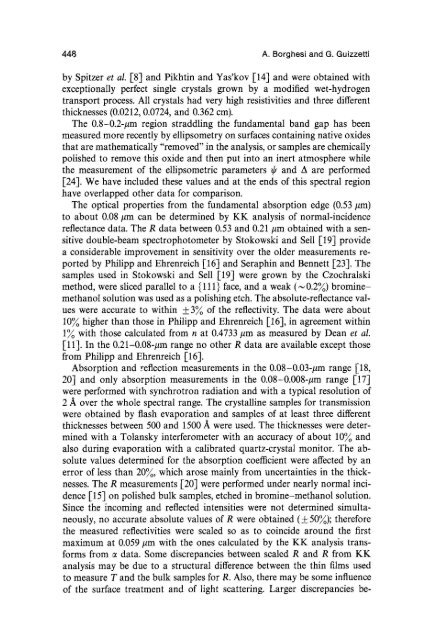Gallium Arsenide (GaAs) - Courses
Gallium Arsenide (GaAs) - Courses
Gallium Arsenide (GaAs) - Courses
You also want an ePaper? Increase the reach of your titles
YUMPU automatically turns print PDFs into web optimized ePapers that Google loves.
448 A. Borghesi and G. Guizzetti<br />
by Spitzer et al. [8J and Pikhtin and Yas'kov [14J and were obtained with<br />
exceptionally perfect single crystals grown by a modified wet-hydrogen<br />
transport process. All crystals had very high resistivities and three different<br />
thicknesses (0.0212,0.0724, and 0.362 cm).<br />
The 0.8-0.2-/lm region straddling the fundamental band gap has been<br />
measured more recently by ellipsometry on surfaces containing native oxides<br />
that are mathematically "removed" in the analysis, or samples are chemically<br />
polished to remove this oxide and then put into an inert atmosphere while<br />
the measurement of the ellipsometric parameters !/J and d are performed<br />
[24]. We have included these values and at the ends of this spectral region<br />
have overlapped other data for comparison.<br />
The optical properties from the fundamental absorption edge (0.53 /lm)<br />
to about 0.08 pm can be determined by KK analysis of normal-incidence<br />
reflectance data. The R data between 0.53 and 0.21 /lm obtained with a sensitive<br />
double-beam spectrophotometer by Stokowski and Sell [19J provide<br />
a considerable improvement in sensitivity over the older measurements reported<br />
by Philipp and Ehrenreich [16J and Seraphin and Bennett [23]. The<br />
samples used in Stokowski and Sell [19J were grown by the Czochralski<br />
method, were sliced parallel to a {111} face, and a weak ( '" 0.2%) brominemethanol<br />
solution was used as a polishing etch. The absolute-reflectance values<br />
were accurate to within ± 3% of the reflectivity. The data were about<br />
10% higher than those in Philipp and Ehrenreich [16J, in agreement within<br />
1% with those calculated from n at 0.4733 /lm as measured by Dean et al.<br />
[11]. In the 0.21-0.08-/lm range no other R data are available except those<br />
from Philipp and Ehrenreich [16].<br />
Absorption and !"eflection measurements in the 0.08-0.03-/lm range [18,<br />
20J and only absorption measurements in the 0.08-0.008-/lm range [17J<br />
were performed with synchrotron radiation and with a typical resolution of<br />
2 A over the whole spectral range. The crystalline samples for transmission<br />
were obtained by flash evaporation and samples of at least three different<br />
thicknesses between 500 and 1500 A were used. The thicknesses were determined<br />
with a Tolansky interferometer with an accuracy of about 10% and<br />
also during evaporation with a calibrated quartz-crystal monitor. The absolute<br />
values determined for the absorption coefficient were affected by an<br />
error of less than 20%, which arose mainly from uncertainties in the thicknesses.<br />
The R measurements [20J were performed under nearly normal incidence<br />
[15J on polished bulk samples, etched in bromine-methanol solution.<br />
Since the incoming and reflected intensities were not determined simultaneously,<br />
no accurate absolute values of R were obtained (± 50%); therefore<br />
the measured reflectivities were scaled so as to coincide around the first<br />
maximum at 0.059 /lm with the ones calculated by the KK analysis transforms<br />
from II data. Some discrepancies between scaled Rand R from KK<br />
analysis may be due to a structural difference between the thin films used<br />
to measure T and the bulk samples for R. Also, there may be some influence<br />
of the surface treatment and of light scattering. Larger discrepancies be-
















